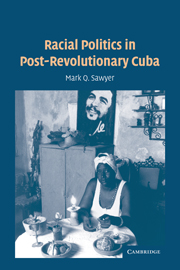Book contents
- Frontmatter
- Contents
- List of Figures and Tables
- Acknowledgments
- Introduction
- 1 Race Cycles, Racial Hierarchy, and Inclusionary Discrimination: A Dynamic Approach
- 2 Freedom and Discrimination: Uneven Inequality and Inclusion in Pre-Revolutionary Cuba
- 3 Race and Revolution: Transformation and Continuity
- 4 Match Made in Heaven or Strange Bedfellows? Black Radicals in Castro's Cuba
- 5 Race and Daily Life in Cuba During the Special Period: Part I: Interview Data
- 6 Race and Daily Life in Cuba During the Special Period: Part Ⅱ: Survey Research
- 7 Racial Politics in Miami: Ninety Miles and a World Away
- Conclusion
- Bibliography
- Index
5 - Race and Daily Life in Cuba During the Special Period: Part I: Interview Data
Published online by Cambridge University Press: 05 September 2012
- Frontmatter
- Contents
- List of Figures and Tables
- Acknowledgments
- Introduction
- 1 Race Cycles, Racial Hierarchy, and Inclusionary Discrimination: A Dynamic Approach
- 2 Freedom and Discrimination: Uneven Inequality and Inclusion in Pre-Revolutionary Cuba
- 3 Race and Revolution: Transformation and Continuity
- 4 Match Made in Heaven or Strange Bedfellows? Black Radicals in Castro's Cuba
- 5 Race and Daily Life in Cuba During the Special Period: Part I: Interview Data
- 6 Race and Daily Life in Cuba During the Special Period: Part Ⅱ: Survey Research
- 7 Racial Politics in Miami: Ninety Miles and a World Away
- Conclusion
- Bibliography
- Index
Summary
On a hot March afternoon in Havana, a Cuban friend and I entered the Havana Libre Hotel and waited to meet with two other friends. We sat at the bar and tried to order drinks. The bartender refused us service, however, and asked us to leave, whereupon a security guard soon followed and escorted us out of the hotel. It bears mentioning that my friend and I are black. My friend, “Pedro,” is a dark young Cuban man with sharp features that denote his origin in Santiago de Cuba. In island terminology, he is an “Oriental.” The type of rude treatment we received would not have been out of character in 1950s America – or in 1950s Cuba, for that matter – but it seemed strange to be at the receiving end of it in Cuba today, in a society in which people of all colors live, work, love, and celebrate – for the most part, together. How, then, can I explain a Jim Crow experience in what appears to be a rainbow society?
Angry and confused, my friend and I left for another establishment. I asked Pedro what had happened. He gave me an explanation that others seemed to agree with: “We are both black and well dressed. I am clearly an Oriental and therefore lower class. You are black and dressed in American clothes. We are, in their eyes, hustlers, criminals.
- Type
- Chapter
- Information
- Racial Politics in Post-Revolutionary Cuba , pp. 102 - 133Publisher: Cambridge University PressPrint publication year: 2005

